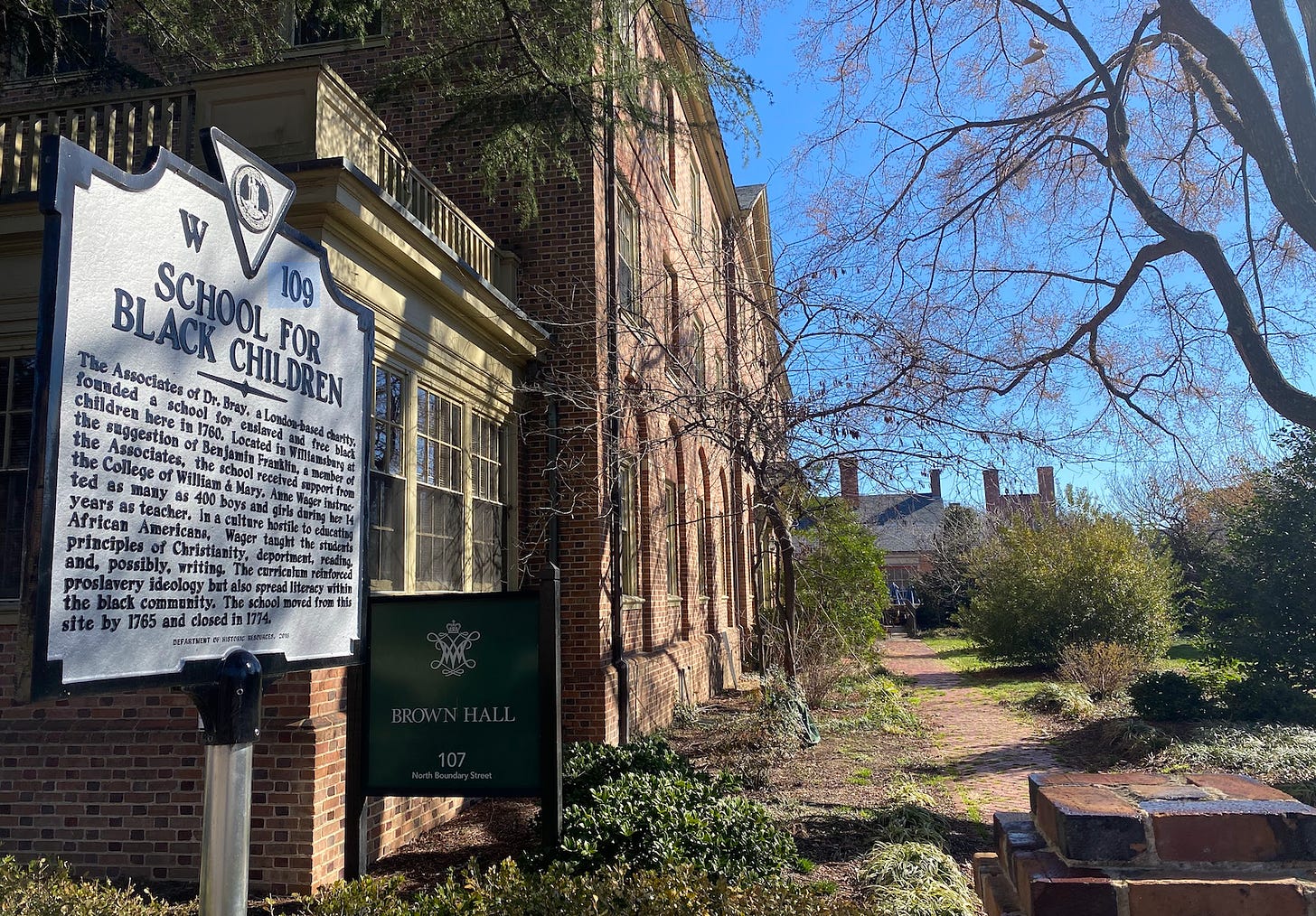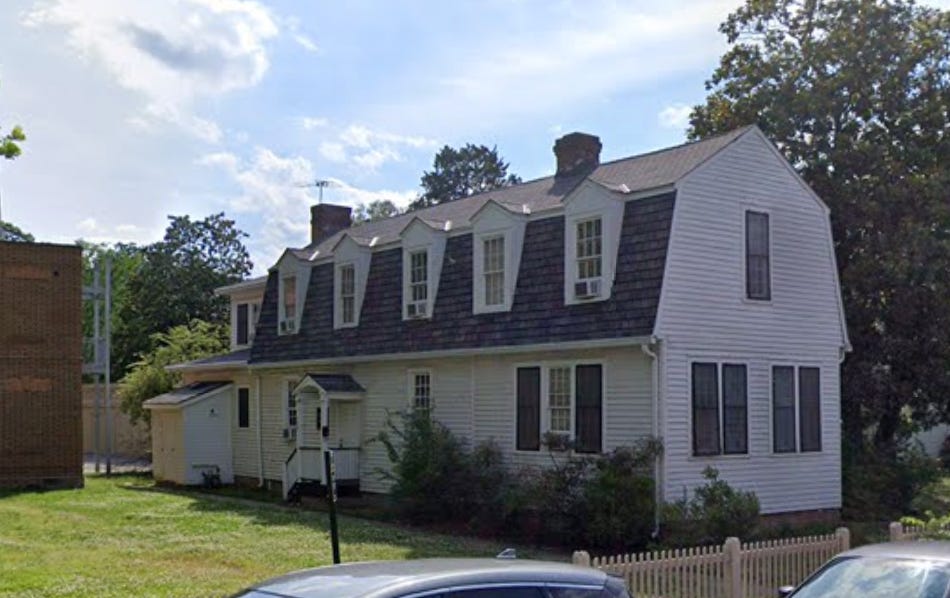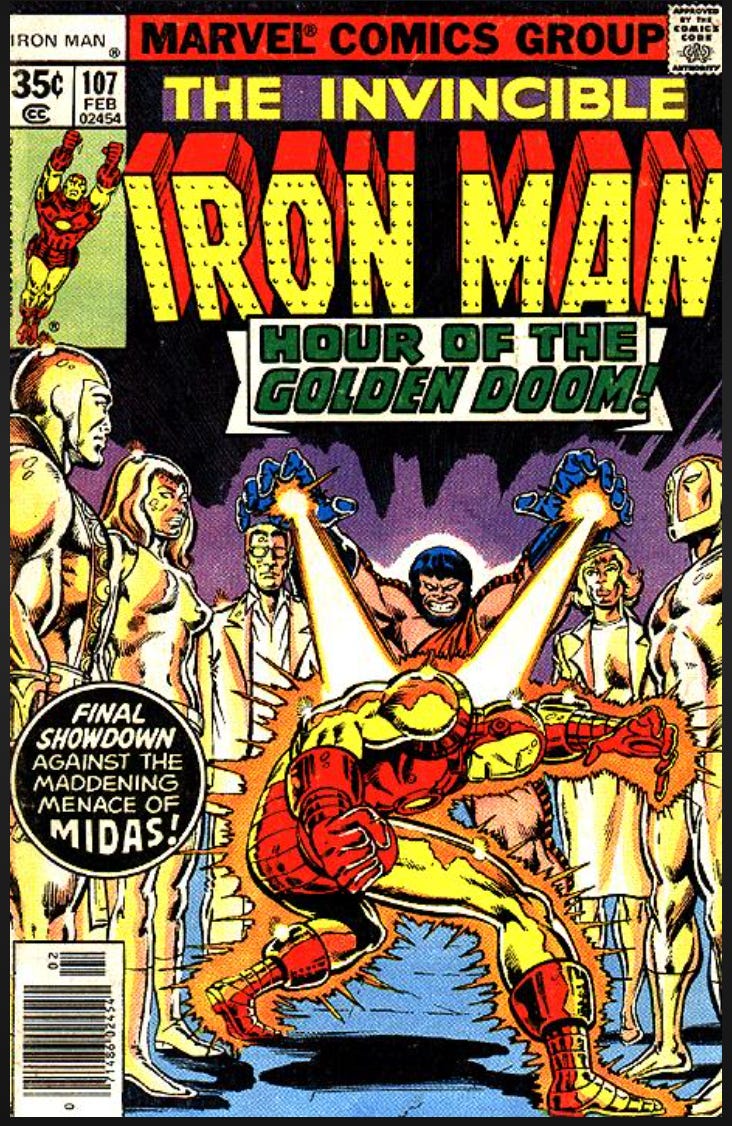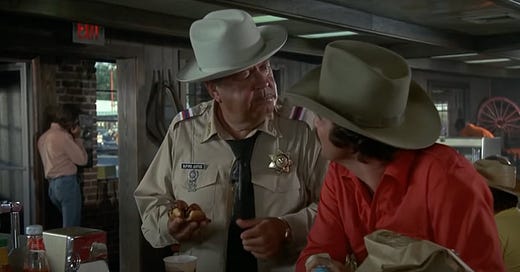

Discover more from Flashlight & A Biscuit
History hidden in plain sight
In Williamsburg, the story of a historical treasure that we all walked right past for so many years
Welcome to Flashlight & A Biscuit, my Southern culture/sports/music/food offshoot of my work at Yahoo Sports. Thanks for reading, and if you’re new around here, why not subscribe? It’s free and all.
Back when I was a skinny undergrad at the College of William & Mary in Virginia, I spent a disturbingly large percentage of my time there at a small record store on Prince George’s Street called The Band Box. This was back during the CD era, so whenever I got paid my pittance for working on the college newspaper — eat that, unpaid college athletes — I would find my way over to The Band Box and sort through all the bins of bootleg and questionably-legal CDs. (One more reason kids today miss out: Spotify robs you of the joy of the hunt.)
Although I didn’t know it at the time — and nor did anyone else, for that matter — every time I walked out the door of that record store, I was looking right at a piece of American history, with no clue that it even existed.
Colonial Williamsburg has gotten an unfair rep as an early-America Disney World, an overly sanitized version of what life was like back in the days of “Give me liberty or give me death!” There’s a thriving archaeological scene in Williamsburg — unlike Disney World, this is actually the literal place where history happened — and every once in awhile, the town gives up a new secret.
One certain white-clapboard, dual-chimneyed, farmhouse-roofed building that stood on Prince George’s Street directly across from the record store was nothing spectacular, visually speaking. There are a few dozen houses exactly like it in Williamsburg, some built (or rebuilt) recently, some from decades or even centuries ago.
But no house in Williamsburg had quite the pedigree of this one.
Back in the early 2000s, an English professor at W&M named Terry Myers learned about a building that had been moved, wholesale, in 1930 from a spot near what’s now the heart of Colonial Williamsburg (that’s the empty space in the photo above) to a spot on campus a few hundred yards away. Moving entire houses was a tricky business, but not an uncommon one. Those bad boys were well-built, from rafters to floorboards to chimneys.
Myers did what any good professor ought to do — started digging — and found letters and records that confirmed his hunch: the building that had been shuffled around in Williamsburg like furniture was, in fact, the Williamsburg Bray School, often mentioned in documentation from the era but long ago believed destroyed.
Opened in 1760, the Bray School was created specifically for the Christian education of Black children, and is almost certainly the oldest such building still existing. Started at the behest of none other than that kite-flying, aphorism-spouting French-lovin’ Benjamin Franklin, one teacher at the school taught as many as 400 Black children for 14 years.
Those years: 1760 to 1774. Yeah, it was not exactly a popular idea in those days to be teaching Black children to read, write and be curious about the world around them. If you learn about Christianity and God’s expectations of humanity, and then you start wondering how that reconciles with slavery, and suddenly all kinds of uncharitable thoughts start rising up in your head.
You can still see, for now, the building that has effectively absorbed and enveloped the Bray School on Google Maps. This was the view I had every time I walked out of the record store:
But the school isn’t at that location any longer, thanks to a massive effort to give it the prominence it deserves.
Like so many legacy institutions in America, William & Mary and Colonial Williamsburg are reckoning with the impact of their early existence on Black community. Slave labor built much of the College and the town, and the school in particular is navigating the balancing act of respecting its existing legacy while recognizing the vast, unacknowledged contributions of unwilling, unnamed, all-but-forgotten slave laborers.
The College and the town are working together to preserve the Bray School building, moving it (again) from its tucked-away spot on Prince George’s Street to a more prominent location a half-mile away. You can see it being sited in its new location in that photo right above. The plan is to convert it into a location for both research and discussion “research, scholarship and dialogue regarding the interconnected, often troubled, legacy of race, religion and education in Williamsburg and in America,” according to a W&M news release.
If that sounds like an impossible mission, well, yeah … it’s going to be a tough path to carve. The historical challenge, of course, is finding the sweet spot of scholarship that gives all proper respect to the people who worked, bled and died in anonymity, while at the same time preserving the parts of our history that remain worthy of the honor. I think it’s possible to do both, but we’ll find out in the coming years.
Archaeology fascinates me — not just the Indiana Jones-trekking-through-forbidden-caves bit, or the diligent-scientists-cleaning-artifacts-with-a-toothbrush drudgery, but the hidden-in-plain-sight relics that persist to this day. Maybe this is because I live in Atlanta, where we go through baseball stadiums like you go through laundry. Jump over to, say, Rome and you’ll see 800-year-old apartment buildings, two-millennia-old plazas and three-month-old McDonalds all side by side. You want a bit of perspective, you’ll find it by standing on centuries-old cobblestones with chariot ruts grooved into them.
Keep your eyes open, my friends. You never know what you’re walking right past.
Let’s talk. What’s the most historically significant building in your town? How do I get there? Can I crash on your couch?
Song of the Week: “Muddy Water,” Zach Person
Houston-raised, Austin-based Zach Person made his national debut on “American Idol,” but don’t let that throw you — this dude soaks the speakers in genuine blues-fuzz grooves. Hints of Buddy Guy, a touch of North Mississippi hill country blues … this is the kind of stuff you don’t hear nearly enough of in 2023. Dig it.
“Muddy Water” and a whole ton of other tunes are always available on the ever-growing Flashlight & A Biscuit Spotify playlist, ready for your listening pleasure.
Menu of the Week: Amber Ox, Willamsburg, Virginia
The legendary Band Box in Williamsburg got replaced by a high-end restaurant called Amber Ox, the kind of clean-up-and-wear-some-slacks you make your parents take you to when they come to town. Strong recommend on the Shrimp & Grits with ham butter sauce.
As Atlanta as it gets
For the love of God, be careful when you do this. You could miss the ball and someone else could catch it! Oh, right, and you could drop your kid over a fence. That too. Man, Braves fans are something special.
The Braves’ postseason begins this weekend, and if you’re an Atlanta fan or Atlanta-adjacent, you know that means the city is in for some emotional swerves here over the coming days. Hold onto your sanity like you’re holding onto a foul ball, Braves fans.
(This GIF courtesy of my day-job newsletter, Read & React over at Yahoo Sports. Subscribe here and get the best damn sports newsletter on the planet for the low, low price of free.)
Thanks for hanging! These are the best days of the year in the South; hope it’s fine wherever you are too.
—Jay
Land Cat, Georgia
This is issue #107 of Flashlight & A Biscuit. Check out all the past issues right here. Feel free to email me with your thoughts, tips and advice. If you’re new around here, jump right to our most-read stories, or check out some of our recent hits:
Power-ranking the foods of the State Fair of Texas
I tried Chick-Fil-A’s Honey Pepper Pimento Chicken Sandwich and lived to tell the tale
The spooky tale of The Witch Girl of Crittenden County
What does “Flashlight & A Biscuit” mean, anyway?
Keep in touch with me via email right here. And load up a to-go box before you leave:
If you dig this newsletter, share it with your friends. Invite others to the party, everyone’s welcome.
Subscribe to Flashlight & A Biscuit
Kick back with some tales of Southern culture, sports, food and music from Jay Busbee. Grill's already hot; drinks are on ice. Pull up a chair.






















Hi Jay, As always, it's thrilling to see what an incredible journalist you have become! Today's article hit especially close to home having helped hundreds of children learn how to read. I moved out of Florida two years ago in part because of the anti-education sentiment that is growing there. It breaks my heart that my grandchildren have to live in a state that encourages book banning.
I now live in Philadelphia and from my apartment window I can see Eastern State Penitentiary. As the website states, "Known for its grand architecture and strict discipline, this was the world's first true “penitentiary,” a prison designed to inspire penitence, or true regret, in the hearts of prisoners. It began operation in 1827 and closed in 1971. Its most famous prisoner was Al Capone. On the other side of my building is The Philadelphia Museum of Art, famous for the Calder mobiles and the Rocky steps. And of course, less than 2 miles away is Independence Hall. Come for a visit anytime!